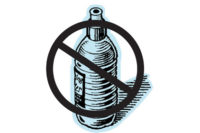U.S. Households Flushing More Organic Material Than Expected Down The Drain
A recent
three-state survey from the University
of Minnesota found that
households are flushing medicines, cleaning, personal care products and more
down their plumbing systems.
Households are flushing more organic material – including medicines and cleaning and personal care products – down the drain compared to historic data, according to researchers at the University of Minnesota’s Water Resources Center (WRC).
The yearlong monitoring of households in Colorado, Florida and Minnesota reinforces concerns that Americans in general may be adding more household chemicals and pharmaceuticals to waste water.
This pilot study, done by the U of Minnesota's Water Resources Center Onsite Sewage Treatment Program team and the Colorado School of Mines, sampled the wastewater of 16 households in the three states for one year beginning in fall 2006. By adding a mechanical diverter to the homes’ sewer, researchers were able to sample water both seasonally and around the clock during a seven-day period for each home.
In addition to an increase in medicines and organic chemicals in the wastewater, researchers found caffeine in all samples that were tested; salicylic acid (the active compound in aspirin) was in about three quarters of samples, ibuprofen in half, and detergent additives and plasticizers in more than three quarters. Researchers also found that water use did not vary from season to season, but was affected by the household’s age, with younger households using nearly twice the amount of water per person than households with occupants 55 and older.
A decrease in the amount of oil and grease flushed down the drain was found. Concentrations of phosphates were also down, due to phosphate-free detergents and household cleansers. The amount of nitrogen in household wastewater remained the same.
“It’s a little like going through someone’s trash can. You get a snapshot of what’s being used inside the home,” said WRC research assistant Jessica Wittwer, who was the field sampler for Minnesota. “While fewer households are flushing oils and grease down the drain, households across the board are using more pharmaceuticals and stronger, anti-microbial and nonbiodegradable cleansers. The concern with pharmaceuticals and nonbiodegradable chemicals is their long-term effect on the larger ecosystem and food chain.”
The Water Resource Center is affiliated with the university’s College of Food, Agricultural and Natural Resource Sciences and University of Minnesota Extension. For more information, visit wrc.umn.edu.
Source: University of Minnesota
Households are flushing more organic material – including medicines and cleaning and personal care products – down the drain compared to historic data, according to researchers at the University of Minnesota’s Water Resources Center (WRC).
The yearlong monitoring of households in Colorado, Florida and Minnesota reinforces concerns that Americans in general may be adding more household chemicals and pharmaceuticals to waste water.
This pilot study, done by the U of Minnesota's Water Resources Center Onsite Sewage Treatment Program team and the Colorado School of Mines, sampled the wastewater of 16 households in the three states for one year beginning in fall 2006. By adding a mechanical diverter to the homes’ sewer, researchers were able to sample water both seasonally and around the clock during a seven-day period for each home.
In addition to an increase in medicines and organic chemicals in the wastewater, researchers found caffeine in all samples that were tested; salicylic acid (the active compound in aspirin) was in about three quarters of samples, ibuprofen in half, and detergent additives and plasticizers in more than three quarters. Researchers also found that water use did not vary from season to season, but was affected by the household’s age, with younger households using nearly twice the amount of water per person than households with occupants 55 and older.
A decrease in the amount of oil and grease flushed down the drain was found. Concentrations of phosphates were also down, due to phosphate-free detergents and household cleansers. The amount of nitrogen in household wastewater remained the same.
“It’s a little like going through someone’s trash can. You get a snapshot of what’s being used inside the home,” said WRC research assistant Jessica Wittwer, who was the field sampler for Minnesota. “While fewer households are flushing oils and grease down the drain, households across the board are using more pharmaceuticals and stronger, anti-microbial and nonbiodegradable cleansers. The concern with pharmaceuticals and nonbiodegradable chemicals is their long-term effect on the larger ecosystem and food chain.”
The Water Resource Center is affiliated with the university’s College of Food, Agricultural and Natural Resource Sciences and University of Minnesota Extension. For more information, visit wrc.umn.edu.
Source: University of Minnesota
Looking for a reprint of this article?
From high-res PDFs to custom plaques, order your copy today!







